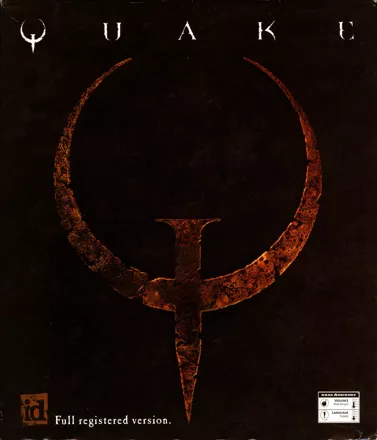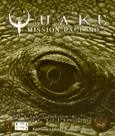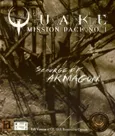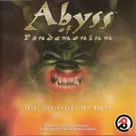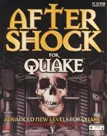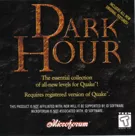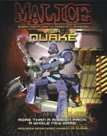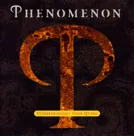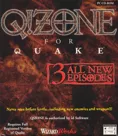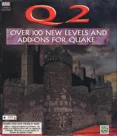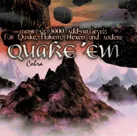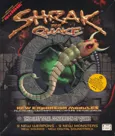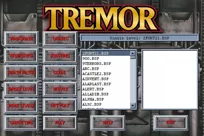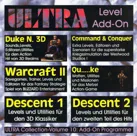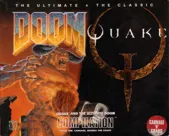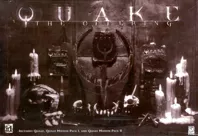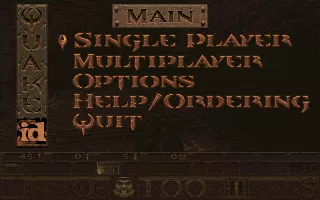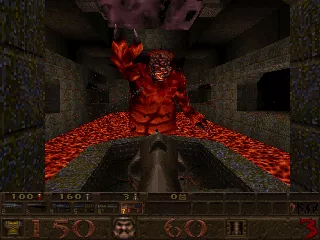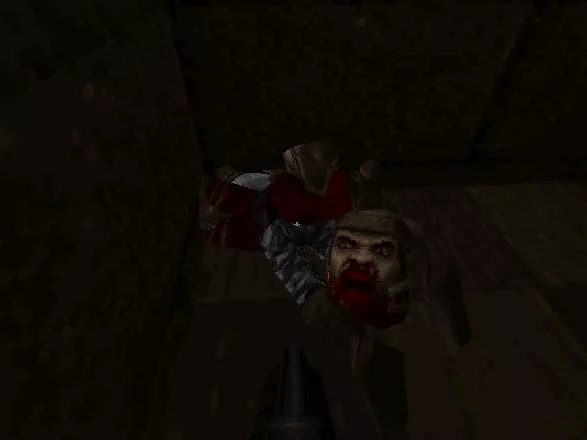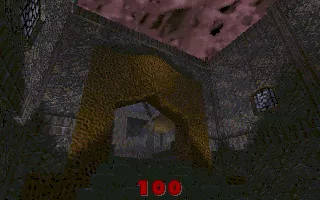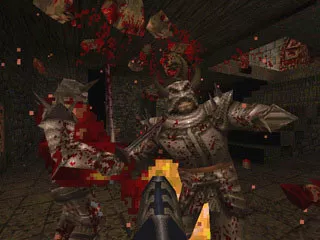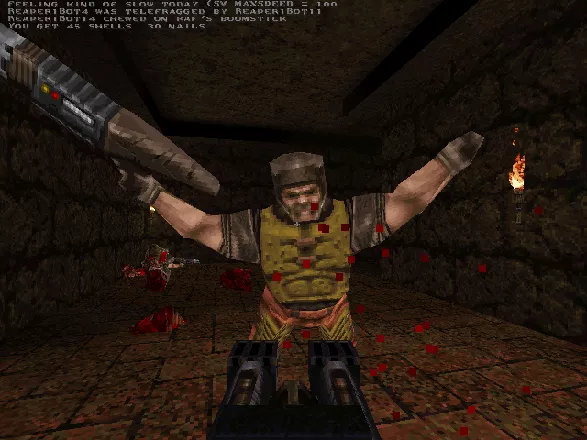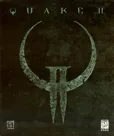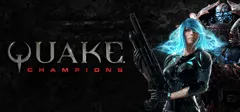Quake
-
 Quake
(2021 on
Windows,
Windows Apps,
PlayStation 4...)
Quake
(2021 on
Windows,
Windows Apps,
PlayStation 4...)
Description official descriptions
An enemy with the codename ''Quake'', which is believed to come from another dimension, is using teleporter gates to invade Earth. The player takes the role of a nameless soldier who arrives at his base only to find out Quake has overrun it and killed everyone. Somewhere in the base, there must be a teleporter to Quake's realm. The mission is clear: take the fight to the enemy, overcome countless hordes of monsters, and exact revenge.
id Software's follow-up to Doom and Doom II, Quake is a first-person shooter. Its main technological innovation is the use of a true 3D engine - the levels themselves, as well as the enemies, are polygonal. This not only allows for more natural level-designs and character animations, but also for more realistic lighting and the inclusion of simulated physics that have an effect on gameplay: grenades can bounce off walls and around corners, for example.
In single-player mode, gameplay consists mainly of proceeding through the levels (spread over four distinct episodes) in search of an exit, killing everything that moves. Interaction with the game world is reduced to a minimum: since there is no use key, buttons are pressed by running into or shooting at them. As in id's earlier games, many secrets are waiting to be discovered, including a few hidden levels.
Unlike Doom's rather straightforward design that couples futuristic environments with demonic imagery, the theme of Quake's levels, enemies, and weapons is not so easily pinpointed. While each episode begins in a futuristic military base (with a technological 'slipgate' as the level exit), later levels take place in environments inspired by medieval fantasy and gothic horror (castles, dungeons, and caverns) and the player passes through magical portals to advance. In a departure from Doom's colorful environments, all Quake levels are dominated by earth colors.
The enemies conform to the mishmash of designs: there are human opponents armed with shotguns and energy weapons in the early levels, while the later levels include medieval knights, ghosts, zombies, ogres (armed with grenade launchers and chainsaws), and some more unearthly beasts. The player's weapons, while relatively modern, all have a low-tech feel. Besides a (bloodstained) axe, there are shotguns, nailguns, rocket and grenade launchers, and the Thunderbolt, which discharges electrical energy.
Quake was one of the first games playable natively over the Internet in addition to LANs. The single-player levels can be played cooperatively, but the game is most famous for its deathmatch mode. One-on-one duels, team play, and free-for-all competition are possible. The emphasis is on fast reaction and skillful maneuvering through the levels. All of the single-player maps can be used as arenas, but the game also comes with six maps specially designed for deathmatch.
Spellings
- 雷神之锤 - Simplified Chinese spelling
Groups +
- 3D Engine: Quake
- 3D Engine: SlaveDriver
- BPjS / BPjM indexed games
- Game feature: In-game screenshot capture
- Gameplay feature: Drowning
- Gameplay feature: Recordable replays
- Games with Dopefish
- Games with officially released source code
- Inspiration: Author - H. P. Lovecraft
- Online Service: Heat.net
- Quake series
- Replay (GT / Infogrames / Atari) releases
- Total Entertainment Network (TEN) multiplay platform
Screenshots
Promos
Videos
Add Trailer or Gameplay Video +1 point
See any errors or missing info for this game?
You can submit a correction, contribute trivia, add to a game group, add a related site or alternate title.
Credits (DOS version)
27 People (15 developers, 12 thanks) · View all
| Programming | |
| Tools Programmer | |
| Level / Scenario Design | |
| Music | |
| Sound | |
| Project Manager | |
| Support | |
| Biz | |
| Biz assist | |
| Special Thanks To | |
| [ full credits ] | |
Reviews
Critics
Average score: 87% (based on 62 ratings)
Players
Average score: 4.0 out of 5 (based on 466 ratings with 19 reviews)
The Good
Graphics. Of course I can't judge this game agains likes of Gears of War, but for that time it was something that absolutely won people's heart, from ghastly corridors to hell's front door. And monsters we're in 3D, not sprites.
Sound. From monster's snores to double-barreled shotgun's sound, it was all in place. Sound is very important in this game, because it adds a little bit to scare factor.
Music. The music fits into game very well and makes you feel the adrenaline.
Multiplayer. It doesn't have the same impact that it had 10 years ago, but MP is still rock solid. Servers are quite lonely, but community is still strong.
The Bad
Single-player and it's story. It's totally dumbed down and everything becomes so repetitive. You just have one objective, finish the level and kill the bad guys. And story is usual "evil tries to demolish mankind".
Textures. Textures are so repetitive, that I wanted to scream. Every level is so earth-like and muddy.
There aren't a lot of bad things about this game, but these few still manage to hurt this game.
The Bottom Line
Game has everything that you need. Superb graphics (at least 10 years ago), scary atmosphere and great sound & music and story (even if it is totally pointless). But SP gradually wears down. At first it's locations are mindblowing and awesome, but after that the textures start to repeat itselves. I was screaming after seeing for the millionth time those same old earth-like textures. There's no variety, almost everything is copy. And objectives are nothing but finish the level and kill baddies. Now, moving to baddies. Actually monsters are quite cool and add spice to the game, from lousy armed men to yeti-like monster. You can see absolutely immediately, that one of the monster designer is Lovecraft fan. And also, the monsters are not sprites but in 3D! That was one of the advancements that iD made.
And the Quake engine is marvellous. With Gouraud shading for moving objects and static lightmap for nonmoving objects. After the source code was released by Carmack in '99, derivative engines came out and these also improved original engine. And of course you can't deny countless maps & mods that came out after the game was released. A lot even surpass original maps and add a lot of variety and exploring. Game's biggest plus is MP. Now it's a little bit aged and servers are often deserted, but I imagine what it was about 10 years ago. It was crowded, people we're thrilled. They chatted, swapped tips and even met each other in real life. Tournaments were held, money won and MP community was growing, growing and growing. That's all thanks to MP, what was those days a big hit. And because of Quake MP's simplicity. You just joined and played, even if you got fragged like hell. Oh well, time to stop bothering you. As I said: The SP is lousy and gradually wears off, but MP is strong. I can see what historical value this game has and what milestone it was, but I still can't blindly shout: Quake owns.
Windows · by Donatello (466) · 2006
The Good
Quake may be an awesome first-person shooter that received praise from the gaming public, but things were very different in 1991, when id first promoted it in the first three Commander Keen games. It was to be called The Fight For Justice, a role-playing game where the player would control someone named Quake, who was supplied with a hammer that they could use against his enemies. People could be interacted with, and there would be many puzzles to solve. He would work for Justice, a secret organization whose purpose is to vanquish all the evil from the world.
This never got off the ground due to the fact that the technology they were using was outdated and they had to wait while they developed a new engine that was capable of delivering the result they wanted. In my opinion, it wouldn't make any sense for id not to cash in on their previous successes (Wolfenstein 3-D and Doom), both of them first-person shooters.
The player's role in the game is to stop something codenamed “Quake”, an evil entity using technology created by the government (known as Slipgates) to insert their own death squads into the 'human' dimension. To do this, the player must navigate from area to area, searching for the four runes that are required to enter Quake's dimension. Having said that, Quake shares many similarities with Doom. You have to search each level for the exit (in this case, a portal), collecting keycards to unlock certain doors, more often than not spawning enemies if you collect them. These enemies are just as stupid as they were before, battling each other out if a projectile meant for the player accidentally hits them.
By watching the running demos in the game, I found out at least two things: that the enemies that composed of 3D polygons that are well animated, and that the depicted environments have that Lovecraftian feel to them. There are four episodes in the game, and each of them is consistent in terms of structure. You start off in sci-fi military installations, but then you eventually fight your way through castles and dungeons, both of them having a medieval or fantasy theme. What I like about most of the levels is looking up at the animated skybox with the moving purple clouds.
The best thing about playing first-person shooters such as Quake is the exploration, and I would rather spend at least 30 minutes exploring every inch of a level than just run through it and complete it in five minutes. Besides, you might discover a secret area you missed before if you spend a considerable amount of time in the level. Some areas are inaccessible without collecting keys or pushing/shooting a series of buttons that are sometimes hard to find. There are heaps of secrets in each level, and when I played a certain map more than once, I was able to discover the ones I missed.
Quake is more unique than any first-person shooter that I played so far. Besides using 3D polygons for the sprites and textures, you select the episode and difficulty not through menus, but by walking through portals that play a vital role in the game. Also, I like the way you have to find another way to defeat the two bosses in the game, using two different methods. Gameplay-aside, I believe that Quake was the first FPS that let you play the game at different resolutions, other than the vanilla one.
There are several enemies that you need to kill along the way. You first face human opponents equipped with shotguns and energy weapons, along with their “best friend”. But later on, you'll face tougher opponents like knights, grunts, scrags, and zombies (with those last three being my favorites). You have an arsenal of weapons you can choose from, and start with an axe and shotgun. In my opinion, nothing beats a good old axe, even if you spend a lot of time killing one of the tougher enemies.
One of the people who worked on the game was Trent Raznor, who happened to be the front-runner of Nine Inch Nails. id originally wanted no music in the game, but Raznor was unhappy with this. Later, he was granted permission to let the band write the music for the game. NIN's soundtrack gives the game atmosphere. Like a lot of games released at the time, the music is laid out on CD audio tracks, meaning that you must leave the CD in the drive in order to hear them.
The Bad
In Doom and its sequel, you can open doors and push switches by walking up to them an hitting a key, adding a touch of realism to the game. But in Quake, this feature does not exist, nor in any other first-person shooter that follows it.
As much as I like the idea of running the game at different resolutions, some of them make the game look distorted if you use odd resolutions such as 320x400 and 848x480. There are even more ones a lot higher up, but I found the performance to degrade quite badly, even if you run the game on a Pentium.
The Bottom Line
In conclusion, Quake is an excellent game from id Software, the creators of Doom and Wolfenstein 3-D. The game was innovative for its time, in the way the characters consist of 3-D polygons that are animated nicely. It also is unique in the way it is structured different to id's previous successes where the difficulty/episode is not selected within a menu, as well as the way the levels are structured. The music for the game is composed by Nice Inch Nails, and they have slapped their logo onto certain ammo crates to make sure you don't forget. Each of the soundtracks in the game is disturbingly good, consisting of ambient noises to heighten the atmosphere of each level. The bottom line: I would recommend Quake to anyone who enjoys playing first-person shooters, especially for the exploration.
DOS · by Katakis | カタキス (43087) · 2016
Great engine!! Great multiplayer code!!... Game? What game???
The Good
Quake was a technological wonder, after Doom id really had a hard act to follow technology-wise, yet they once again proved their programming prowess with Quake = the first fps with a true 3D engine.
And what an engine it was! After years of being stuck on the world of 2.5D games, Quake finally delivered true polygonal bliss. The end result was pretty much obvious: better sense of space and depth, smoother animation, use of effects like the portal or the cool underwater-distortion one, etc. etc. Quake also applied it's 3D-ness to such things as the player's Pov, which swayed and leaned around quite realistically. A feat that really made the game feel a lot different from the now static-looking 2.5D fpss; ditto the character models, which moved way smoother than sprites, and also came with the added bonus of being able to explode in little chunks of red meat, yes boys and girls, "gibs" were born with Quake.
The multiplayer area is also the other point were Quake broke the mold. As everyone knows by now, the game replaced all the hassle of multiplayer net-play with the now common server-client architecture, which was not only much more intuituive, but also much more reliable and fast, especially when you consider the setup prep-work that was usually involved with multiplayer gaming.
Also, being a metal fan I really enjoyed NIN's contribution to the game's soundtrack, tough it seems to be too depressing/experimental to most players for some reason. Still, if you don't like it, you can always pop in your own audio cd and let 'er rip while you get it on.
The Bad
What "didn't" I like about the game?? Well, there's no game to speak of!! :)). Seriously, Quake would begin id's trend of just forgetting about game design and instead providing the best technological wonders they could come up with. This is especially evidenced by the open architecture of Quake. It's set-up so you can customize it to your liking, ad mods to it, ad skins, textures, levels, sounds, etc etc. Heck, they even released the source code!
Id just figured "Why the hell bother designing the game when we just can release the technology?" It may be a reprehensible idea, but it's smart! Think about it, Quake off the box was a piece of shit. The game itself has even less story than Doom (and you thought that wasn't possible!!), the weapons are copies of Doom's (save for the Axe and the Lightning-throwing thingie) with new yet crappy 3D models (the rocket launcher is just a brown rod!!), the level of interaction was toned down to near-retarded levels with the removal of the use key in favor of a jump key, essentially trading off the ability to use things for the world's crappiest jump (primary reason for the discovery of the rocket-jump) result? You activate gigantic buttons by bumping into them... groan....
But wait! That's not all! The levels are dull techo-goth places with a heavy dose of the brown color (hmmm, crap comes to mind in more ways than one!!), populated by stupid traps (??WTF??) and seemingly randomly-placed enemies, which to be fair are the only cool things that come with the game. The single player campaign is a joke, with the only good moment being the fight against Chthon at the end of episode 1 and the initial joy of watching everything in 3D and all the Lovecraftian imagery. The multiplayer part saves the game, but then again the maps that came with the game were sorely lacking in just about every level.
...yet...
The Bottom Line
Quake sold Gazillions of copies!!! Why? Because it didn't matter whether it was good or not off the box!! You bought the game, and then turned it into whatever you wanted! And I'm not just talking about the level add-ons and stuff like that, I'm talking about serious reworkings, like Quake Rally and the like.
Quake is sort of like a piece of real estate, get it? It's what you put in there that eventually turns the game a worthy experience. It's a piece of remarkably well made technology, with enough of an open architecture to satisfy most pseudo-designers (though it would still require a high level of proficiency to do stuff like "real" level editing). That's what you pay, and that's what you get. Not a game, but a 3D-enginered, multiplayer-capable, piece of clay. This is good, REAL good. On the other hand it's pretty shameless in the sense that the developers simply washed their hands of most, if not all, creative content... hmm. That's bad, real bad...
In the end you'll have to ask yourself what do you really want. Back on those days Quake meant 3D and multiplayer. If you wanted that, you went for that. If you wanted say... good fps gameplay, you went for Duke3D (or even Quake add-ons like Scourge of Armaggon) and the like. You had to think before you bought. Of course, nowadays it's just completely stupid to play Quake. No reason to bother with old technology when you can have the new and upgraded version: Quake 3 Arena, even less of a game than this one, and destined to the same oblivion as soon as Quake 4, 5, 6, etc. get released.
DOS · by Zovni (10504) · 2002
Discussion
| Subject | By | Date |
|---|---|---|
| Paul Steed credit | leilei (343) | Aug 13, 2012 |
| What music? | null-geodesic (106) | Jun 12, 2008 |
Trivia
1001 Video Games
The PC version of Quake appears in the book 1001 Video Games You Must Play Before You Die by General Editor Tony Mott.
Scrapped versions
The Game Boy Advance version of Quake was in development by AGB Games. There were also plans for port to Sony PlayStation by Lobotomy Software, which was able to work, under some circumstances, in 60 FPS. First one was cancelled for unknown reasons, while second cancellation was caused by fact, that developer failed to find a publisher.
3D cards support
The original game had software rendering mode only. You could download glquake to use your 3d accelerated card. A special version was made for the intergraph rendition cards called vquake.
Anaconda level
Bizarre product tie-ins: for the release of the movie Anaconda, Sony pictures released through their website an add-on level for Quake titled Temple of the Mist were you made your way trough an ancient temple searching for the altar that holds the key to escape. Obviously, before escaping you have to go mano a mano with the Anaconda itself...weird uh?
Development
The original Quake was supposed to have a medieval environment, but a few months before its release, most of the medieval-role playing aspects of the game were removed (i.e. one of the weapons was going to be a sword and there was a dragon to fight with) and the result was a game with guns but such enemies like the fiend or the death knight (these were included in the original project). Many original design elements were scrapped -- the kernel idea behind Quake was this massive Thor-like warhammer that you could slam down on the ground to make shockwaves ripple through the game world. This "ultimate weapon" idea followed John Romero to his game Daikatana.
The original concept was inspired by a character named Quake in id's long D&D campaign (which actually ended with demons destroying the universe due to John Romero's greed), DM'd by John Carmack. Because of the switch to sci-fi, Romero was angry enough to leave id after Quake, even though Carmack fired him first. He later used another inspiration from the D&D campaign to make Daikatana.
Deathmatch
Kornelia, a famous female Quake player, won the "TEN GibFest Contest" at the computer game developers conference at Santa Clara. As a result, she was afforded the opportunity to play John Romero in a 1v1 deathmatch. She beat him 22 to 1 and also took home a P200 MMX system.
Dopefish
Quake is yet another of id Software's games that contains the infamous Dopefish. The level you can find the Dopefish on is E2M3, The Well of Wishes, in a secret location that you'd probably need a walkthrough to get to. Incidentally, "The Well of Wishes" is the same title as a Commander Keen 4: Secret of the Oracle level where the Dopefish first appears.
Engine
The engine that iD Software started to make Quake with was called Six Degrees of Freedom
German index
On August 31, 1996, Quake was put on the infamous German index by the BPjS. For more information about what this means and to see a list of games sharing the same fate, take a look here: BPjS/BPjM indexed games.
IFQuake
Taking John Romero's work on the Apple ][ bootloader for Infocom's Zork Zero as a point of departure, in 2004 Jason Bergman released IFQuake -- the difficulty-selection stage and first level of the shareware version of Quake implemented as a text adventure game, downloadable at http://mirror.ifarchive.org/if-archive/games/zcode/ifquake.zip
Innovations
Almost incidentally, Quake introduced the now-standard concept of a FPS 'console', and popularised 'mouselook' as *the* absolute standard control interface. Although the specifications required a Pentium, Quake ran acceptably well on a 486 DX4/100 and, at a push, the faster 486es. Along with Magic Carpet it was however the game that most established the Pentium as a must-have processor. It was also the first game which offered the opportunity for both Amiga and PC gamers to play online together.
Machinima
Machinima, an animated film using the 3D environment of a game, started with the Quake engine. Doom already had a recording feature, but it wasn't until Quake when people added narrative and called it "movies" that the genre was born. The first known machinima is Diary of a Camper, by a group of players called The Rangers, released on October 26, 1996.
Qtest1
Quake was preceded by Qtest1, a tech demo which was released in February 1996. It consisted of three small, monster-free levels which illustrated the game's engine. Of particular note was Test3, which became the basis for the second level of Quake's first episode (of the other levels, Test2 seemed to be a very, very early incarnation of 'Ziggurat Vertigo', the infamous low-gravity secret level). The engine was almost fully complete, although wall-mounted torches were still sprite-based.
Although the test had no game - rather like the original Doom 'alpha releases' - multiplayer support was, fortunately, included. The infamous 'rocket jump' was discovered quite quickly, as Qtest included both rocket and grenade launchers.
"Chris ([email protected])" eventually discovered that monsters were included in the game's source code, and a patch released in June 1996 allowed players to experience early versions of Quake's beasties.
References
All of the sounds and music for Quake were produced by Trent Reznor, the man behind the industrial/alternative group Nine Inch Nails. The ammo boxes for the nailgun ("nails") have the band's logo (NIN) on the side.
References to the game
One of the songs on Karl Sander's album Saurian Meditation, "Elder God Shrine", was named after the Quake level E4M3 which has the same name.
Saturn version
The Saturn version of Quakeis the only version with coloured lighting, something Lobotomy Software added to the saturn version
Source code release
In 1999, id Software made the complete source code for Quake freely available to the public. You can download it here.
Speedruns
Quake inspired the art of speedruns: trying to beat a game as fast as possible. The initial release was Quake Done Quick, completed in 19:49 and released on 1997. As of 2012, players still work on breaking the latest records.
Zeeboo version
On June 15, 2010, both Quake and Quake II were removed from Zeebo's wireless network, the Brazilian Zeebonet. Both games were offered for 10 Z-credits and each Brazilian Zeebo came with 35 Z-credits, so the games were sold virtually for free. They were replaced for Zeebo Extreme Rolimã and Zeebo Extreme Jetboard as free downloads.
Awards
- Computer Gaming World
- November 1996 (15th anniversary issue) - #36 in the “150 Best Games of All Time” list
- November 1996 (15th anniversary issue) – The Best Way To Die In Computer Gaming (being telefragged)
- November 1996 (15th anniversary issue) –Worst Back Story of All Time
- November 1996 (15th anniversary issue) – #5 Least Rewarding Ending of All Time
- May 1997 (Issue #154) – Action Game of the Year
- May 1997 (Issue #154) – Action Game of the Year (Readers' Choice)
- May 1997 (Issue #154) – Special Award for Technological Achievement (for its engine)
- April 1999 (Issue #177) - Introduced into the Hall of Fame
- March 2001 (Issue #200) - #8 Best Game of All Time
- GameSpy
- 2001 – #5 Top Game of All Time
- GameStar (Germany)
- Issue 12/1999 - #7 in the "100 Most Important PC Games of the Nineties" ranking
- PC Gamer
- April 2000 - #14 in the "All-Time Top 50 Games" poll
- April 2005 - #26 in the "50 Best Games of All Time" list
- Power Play
- Issue 02/1997 – Best Multiplayer Game in 1996 (together with Jagged Alliance: Deadly Games)
- Świat Gier Komputerowych
- February 1997 (Issue #50) – readers' award Hitek'96 for the best foreign game of 1996
Information also contributed by Adam Baratz, Ashley Pomerov, chirinea, Darksaviour69, D Michael, Erkan O; keth, Maw, n-n, PCGamer77, Pseudo_Intellectual; Sciere, Scott Monster, Xoleras, Zack Green and Zovni
Analytics
Upgrade to MobyPro to view research rankings!
Related Sites +
-
FitzQuake
The most faithful custom engine available. -
Func_Msgboard
An ever-active forum dedicated to custom mapping, primarily focusing on the original game but also covering the following games in the series from time to time. -
Matt Chat 54
Video interview with John Romero about the development of Quake -
Planet Quake
An exhaustive quake site visit it for news, mods, levels, tips and all you want related to Quake -
Quaddicted
The most comprehensive site for custom singleplayer maps. -
Quake
Official page on id Software's website -
Quake cheat codes
Detailed information on Quake 1 cheat codes for N64, PC and Sega Saturn -
Tenebrae
Tenebrae is a modification of the quake source that adds stencil shadows and per pixel lights to quake. Stencil shadows allow for realistic shadow effects on every object in the game world. Per pixel lighting allows you to have fine surface details correctly lit. These are essentially the same algorithms as used by the new Doom game.
Identifiers +
Contribute
Are you familiar with this game? Help document and preserve this entry in video game history! If your contribution is approved, you will earn points and be credited as a contributor.
Contributors to this Entry
Game added by robotriot.
Zeebo added by chirinea. Nintendo 64 added by Kartanym. Windows Mobile, Acorn 32-bit, Amiga added by Kabushi. Windows added by The cranky hermit. Macintosh added by Ace of Sevens. SEGA Saturn added by quizzley7.
Additional contributors: JubalHarshaw, Andrew Hartnett, Ledmeister, Roedie, Unicorn Lynx, Atomic Punch!, erc, Kabushi, Patrick Bregger, Titan10, Karsa Orlong, MrFlibble, FatherJack, R3dn3ck3r.
Game added November 3, 1999. Last modified March 6, 2024.
